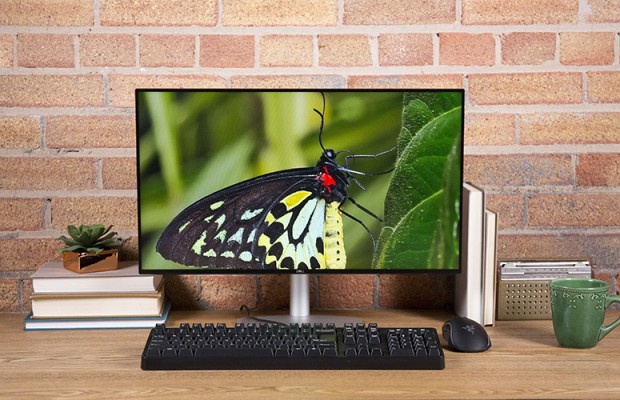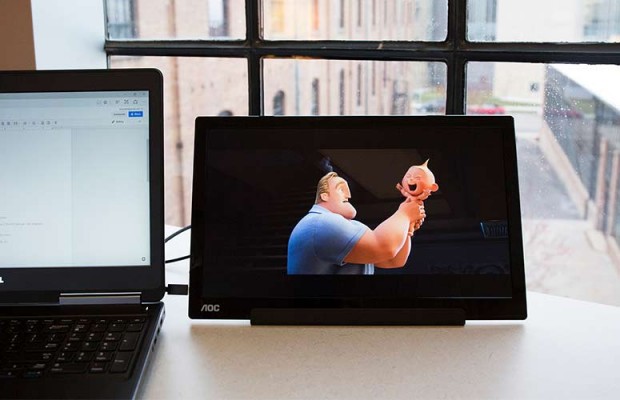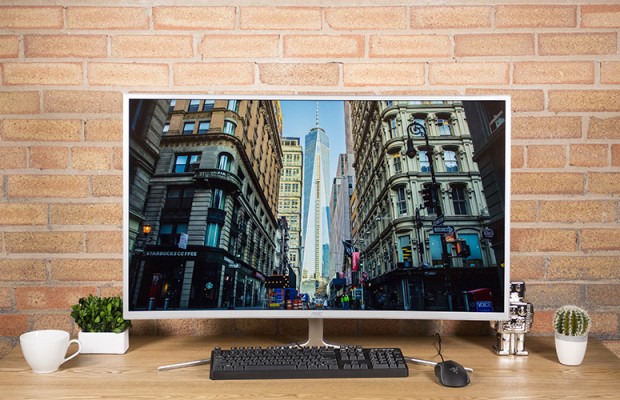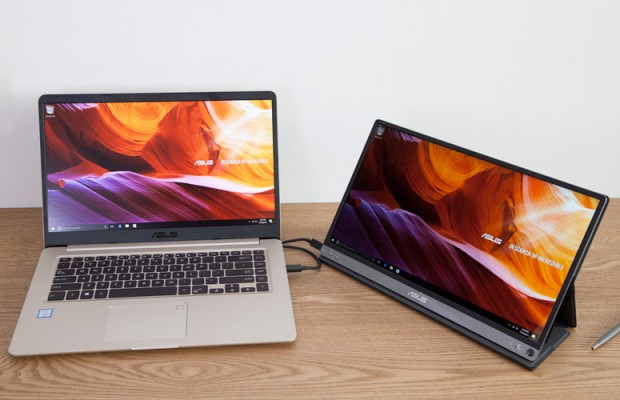Dual Monitors vs. Ultrawide Displays: What Should You Buy?
If you want to get a second or third monitor, you probably already know that it will boost your productivity. But how much can an extra monitor help? Can you get the same benefits from a single wide-screen display as you would from two side-by-side monitors? We set out to find the definitive answers to all these questions and more.
Two major studies first touted the benefits of switching to dual monitors. One came out of the University of Utah in 2003, and discovered that adding a second monitor led to major improvements in productivity. Task focus improved, recovery from mistakes was easier, and switching between documents and apps was smoother. The biggest takeaway: Overall productivity improved by 29 percent. A similar report from Jon Peddie Research in 2002 showed productivity increases of 20 to 30 percent with the addition of a second display. With these two studies, it became commonly accepted wisdom that more screens equal greater productivity.
We've looked at the latest research to find out how valid those claims of improved productivity really are in 2018. We read industry reports, dug up white papers and plowed through more than a couple of academic studies to find out what really matters when you're adding a monitor or two to your workspace.
Quick tips:
- More screen space results in better productivity.
- Multiple monitor setups offer improvements to ergonomics and user satisfaction.
- Wide screens are great, but they aren't always better.
- Curved screens offer better visibility on ultrawide monitors.
- Customizing your display setup leads to the maximum benefit.
New changes in the monitor world
Those first key studies came out when Windows XP was the operating system of choice and flat-panel displays were just hitting the market. In the intervening years, the landscape has changed, with monitor technology improving, processing power allowing for more flexible options for displays and graphics, and multiple-monitor setups becoming common. How common? According to a 2017 study by Jon Peddie Research, the use of two or more monitors has grown from less than 30 percent of those surveyed in 2002 to as many as 90 percent in 2017.
Bigger displays have also become more affordable; whereas 18-inch displays were once prohibitively expensive, today there are budget screens measuring 22 inches or more, such as the Dell Ultrathin S2419HM. As the gap between monitor and TV has narrowed, larger displays, like the AOC 40-inch 4K Monitor (C4008VU8), have started to show up in offices and homes.
Sign up to receive The Snapshot, a free special dispatch from Laptop Mag, in your inbox.
Aspect ratios are different, too. Square displays have largely been supplanted by wider screens with 16:9 and 21:9 aspect ratios, such as the Dell P3418HW. And ultrawide displays that stretch aspect ratios even further have started cropping up. For example, the 49-inch Samsung CHG90 has a 32:9 aspect ratio — effectively two 16:9 monitors' worth of display side by side.
MORE: Highest Resolution Screens
Resolutions have also changed, with full HD (1920 x 1080) becoming the common standard and higher resolutions, like WQHD (2560 x 1440) and 4K (3840 x 2160), gaining market share. And features like touch screens and curved displays have added new possibilities that simply weren't available 10 years ago.
Biggest monitor improvements
Jon Peddie, a longtime industry observer, cited several major evolutions in the monitor space. First, he highlighted improvements in software, saying, "It used to be getting two monitors to work together in a PC required special hardware and software; there were even startup companies formed to serve that need," he told me. He cited the improvement of Windows' display management as a major enabler of common multimonitor usage.
But Peddie also said changes in hardware have helped make dual- and triple-screen setups common. "During that same period of time, we saw monitors' sizes go up, resolution go up, performance go up, color depth go up and prices come down," he noted.
Connectivity has changed as well. Whereas the old, bulky VGA and DVI connectors had 15 to 24 pins that could easily be bent during travel or mangled when you were improperly connecting or disconnecting a display, newer standards, like HDMI and DisplayPort, have smaller and more durable designs.
Mike Nash, HP's vice president of customer experience, noted that monitor connectivity and management have evolved substantially over the years. He pointed to USB Type-C and Thunderbolt technology as the natural end point of that evolution, as they combine power and connectivity into a single connection.
"The biggest game changer has to be USB-C," Nash told Laptop Mag. The smaller connection is more convenient, thanks to touches like a reversible connector, he said, and it also adds power and greater bandwidth that make it possible to run multiple displays over a single connection while still supporting other peripherals.
Finally, the computing world has gone mobile. Multiple monitors used to require desktop PCs, but most people today use a laptop as their daily driver, even for deskbound work. Second monitors, like the portable AOC I1601FWUX, can even be taken on the road.
MORE: Laptops with the Best Display Brightness
As processing hardware has evolved, the need for special graphics cards and software to drive multiple screens has been greatly reduced, letting users simply plug extra monitors into their laptops. And unlike in years past, most users know that their laptop can be used with multiple monitors.
Current research: More screen space is better
To find out if the use of multiple monitors really increases productivity in 2018, we looked at recent research. As with the prominent studies that informed the multiple-monitor push of the 2000s, we've looked primarily at corporate-sponsored research and white papers, so take it all with a grain of salt; of course, monitor makers want to sell more monitors, so they will obviously tout information that suggests the benefits of doing just that.
That said, most manufacturer-produced white papers still take care to cite existing research, and even the companies that produce such studies for a sponsor take care to remain independent and make sure the data holds up on its own.
Jon Peddie Research, the same organization that conducted the 2002 report, has continued to keep an eye on multiple-monitor usage and released a report on the subject in 2017. In a survey of over 1,000 users, companies provided estimates of actual or expected improvement in productivity. The report found that productivity improvements might actually be better than the 20 to 30 percent that older studies had suggested.
"We found that users of multiple monitors have an average expected productivity increase of 42 percent," Peddie said in a statement discussing the report. The basic truths behind those initial studies still hold true: You can see more on multiple displays, which lets you do more.
MORE: Laptops with the Most Colorful Screens
In 2011 research by the Software Usability Research Laboratory at Wichita State University (commissioned by Dell), study participants were tracked as they performed a number of business tasks. Over the course of the study, the participants not only completed projects faster — 18 percent faster, with a 15-percent reduction in switching between windows — but also reported that finding information was easier. The majority (91 percent of users in the study) ranked dual monitors as substantially more useful than single screens, even going so far as to report that a pair of 17-inch displays was preferable to a single 22-inch monitor.
Key takeaway: More screens mean more viewable real estate, which improves productivity. If you can see more, you can do more.
Ergonomic and psychological benefits
A separate Dell-sponsored report from 2011, prepared by Ziff Davis Enterprise, discusses the results of the Wichita study, noting that there are other benefits of dual-display workspaces. The report pointed out that even the use of a laptop and monitor as dual screens provides greater employee satisfaction and comfort, and even results in "greater employee creativity."
A case study commissioned by Samsung in 2015 attributed that increased comfort and satisfaction largely to the ergonomic benefits of using multiple monitors. The case study quoted Phyllis King, associate director of the Center for Ergonomics at the University of Wisconsin-Milwaukee College of Health Sciences, who said, "Studies have shown increased productivity from using dual monitors. A byproduct of that is more comfort, a better workload and a higher level of satisfaction and feeling of support in the workplace."
The study also indicated that improvements in display technology — specifically, higher resolution, better backlighting and richer color quality — have resulted in better readability, reduced the risk of eyestrain and led to a more immersive user experience.
To get an expert opinion, we spoke to Bernard Martin, from the Center for Ergonomics at the University of Michigan. The issues of head orientation and elevation are the same whether someone is using one monitor or many, he said, but multiple monitors may encourage more head movement.
MORE: Best and Worst Laptop Brands
"A single screen may avoid large changes in head orientation, which is good and bad at the same time," because it minimizes head movement, he said. "Some movement is good for the muscles," Martin added.
Key takeaway: Multiple-monitor setups offer better ergonomics and user satisfaction.
What about single wide screens?
But the same benefits also seem to extend to monitors that offer wide-screen (16:9) or ultra-wide-screen (21:9) aspect ratios. A 2015 white paper from ViewSonic suggested that the productivity gains offered by multiple screens depend more on total screen real estate than on separate, distinct monitors.
In a 2015 IDC report on ultrawide and curved monitors, researchers pointed out that the more common 16:9 wide-screen display still presents some limits, with users scrolling and toggling between applications to use multiple documents or programs. The study noted that an ultrawide monitor can alleviate this, because "a 21:9 aspect ratio … provides much more contiguous real estate to the user."
Martin suggested that some of this benefit may be cognitive. "[It] may be easier to separate and retrieve windows on separate screens than on a single large screen," he told Laptop Mag.
One huge flaw of ultrawide monitors: You generally can't use multiple apps in full-screen mode. Having separate, dedicated screens allows a user to open a full-screen app or video on one monitor while continuing to work on another.
There are options for doing this on some larger displays; the 40-inch AOC 4K Monitor (C4008VU8), for example, can be divided into four 1080p quadrants that can feed from separate video inputs, effectively running as four independent monitors. But this capability is still something of a novelty, and most 21:9 monitors still function as single, elongated displays.
MORE: The Best Gaming Desktops Available Now
And there's one other consideration: It may be easier and cheaper to add a second monitor alongside an existing display. Whether you're paying out of pocket for your own displays or asking for more screen space at work, it may be more expensive to buy a wide-screen display than to simply pick up a second of the sort you already have.
Key takeaway: Wide screens are great, but they aren't always better.
New considerations: Flat vs. curved displays
The other drawback of ultrawide monitors is visibility. The Dell-sponsored IDC report pointed out that "using a flat panel on such a wide monitor can often be tiring on the eyes, as it requires users to strain to see information on the far left and right sides of the screen." This can be especially irritating for spreadsheet users — ostensibly one of the groups that benefits most from wider aspect ratios, as densely packed cells and figures may be harder to see when positioned at the outside edges of the screen.
Color quality is another concern. Ultrawide flat-panel displays sometimes have viewing-angle issues because the outer edges of the display are farther away from the user. While that may not be a problem for typing documents, it's probably a deal breaker for anyone who needs accurate color reproduction for photos or video.
A curved monitor can address both issues. Nash touted the benefits of curved wide-screen displays. "It gives you two times the real estate, but it's one big screen, with full visibility," he said.” With the right curvature, such as that on the Dell P3418HW 34-inch Curved Monitor, the right and left edges of a wide-screen or ultra-wide-screen display are brought comfortably into view. The result is both easier viewing, with the entire screen at the same focal depth, and accurate color from edge to edge. In the IDC study, individual respondents actually found that the curved screen offered better accuracy for viewing images, straight lines and vector art.
Key takeaway: If you want an ultra-wide-screen display, go for a curved one.
Customization is king
One of the major benefits of multiple monitors and new display technologies is the opportunity to adjust your workspace to your specific needs. This may manifest in how you arrange your monitors, allowing you to designate one as the primary display and the other as a secondary one, or to use two displays as a single extended desktop.
When pairing monitors with a laptop, you have other options. You can set up the laptop as a third display, in a 2+1 configuration, or you can set it as your center display, devoting the secondary monitors to other uses, like gathering research materials.
Additionally, second and third monitors don't have to be grouped horizontally. Thanks to adjustable height stands and flexible mounting options, screens can be set one above another, providing vertical flexibility in your visible real estate.
Other setups allow further fine-tuning. Many 16:9 monitors allow screen rotation, letting you put the display into portrait mode for more vertical space. This can be especially helpful for reading long documents or viewing longer web pages without scrolling.
MORE: USB Type-C FAQ
Another possibility is the ability to use multiple displays on the go, thanks to new portable monitors that connect over USB Type-C, such as the AOC I1601FWUX and the Asus ZenScreen MB16AC. These small monitors are similar in size to laptop displays or large tablets, and usually come with their own stands. These small displays can be slipped into a laptop bag and easily be set up for more productive work on the road. And because USB-C delivers both power and a video signal, there's no need to break out a power strip to plug everything in.
Key takeaway: Make the most of your workspace by setting up your display(s) to suit your own needs and preferences.
Credit: Laptop Mag





